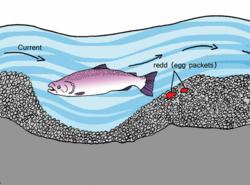Gold Prospectors Association of America: Two retired EPA scientists say suction dredge mining does not harm fish and can actually improve fish habitat.

Despite claims by environmentalists that small-scale suction dredge gold mining harms fish, it can actually improve fish habitat, scientists say.
Radical claims by some environmental groups in recent years have led to a suction dredging ban in California, while the practice remains legal in all other U.S. states.
The Gold Prospectors Association of America and land rights groups, such as Public Lands for the People and the Western Mining Alliance, have strongly opposed the ban.
Claudia Wise and Joseph Greene, worked for the U.S. Environmental Protection Agency for more than 30 years. Wise is a retired physical scientist and Greene is a retired research biologist. Both scientists have done extensive research on the issue and cannot find any evidence to substantiate claims made by environmental activists that suction dredging harms fish or fish habitat.
They say suction dredging can benefit salmon and other species of fish by improving habitat in rivers and streams.
“Any negative effects of suction dredging on fish or fish habitat are insignificant. The benefits definitely outweigh any of the negative effects in any of the studies I’ve ever seen,” Wise said in recent interview.
In almost every study, the environmental impact of suction dredge mining on fish — including salmon — and fish habitat has been proven to be “less than significant,” Greene said.
Dredging improves fish habitat by creating pockets in the bottoms of riverbeds and stream beds. These depressions are ideal places for fish, especially salmon, to spawn when there are limited natural areas of loose gravel, called refugia.
“It’s a pool of water within the river you might say. If it is three feet deep, it’s considered refugia, which is a depression in the river bottom that is under the main currents where fish prefer to rest in cooler water, lots of times at the mouth of a tributary,” she said.
“There are so many benefits to it,” said Wise, explaining that the gravels in many rivers and streams have become so compacted over the years that the fish cannot always find a natural place to spawn.
Because suction dredgers break up or loosen the gravels and create small pockets in the bottoms of streams, it often creates man-made refugia, where none had previously existed.
While opponents of suction dredging argue that fresh dredge tailings (gravels), are not as stable as natural gravel beds, they are better than nothing where natural gravels don’t exist, Wise said. “However, the salmon are smart enough to recognize the difference between natural and man-made refugia,” Greene said.
If there is no suitable place to spawn, the fish will spawn anyway.
“The eggs will just be floating down river and be eaten by any predator that would eat them. They have to get through the gravel to build that nest.” he said.
After dredge tailings have settled for a year, they become more stable and more attractive to salmon.
“By the next year, you’ve got great spawning gravel,” Wise said.
So, adding more refugia means salmon have more places to spawn which helps to increase salmon populations. Even one redd (nest of salmon eggs) can contain thousands of salmon eggs, she said.
“One egg mass is thousands of fish. With one egg mass you’ve made a big difference in some rivers,” she said.
Read more about the science — and politics — of dredging
This press release is presented for your information only.
Full Disclosure Statement: The GREEN (LIVING) REVIEW received no compensation for any component of this article.
This article is for your information only and the GREEN (LIVING) REVIEW does not (necessarily) approve, endorse or recommend the product, service or company mentioned.























